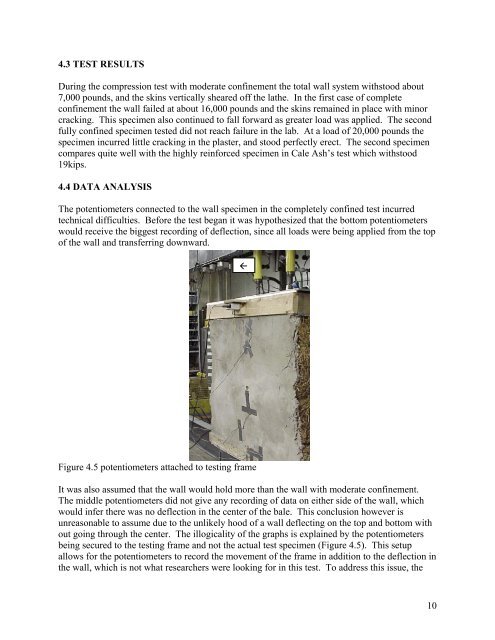the effects of plaster skin confinement on the performance of straw ...
the effects of plaster skin confinement on the performance of straw ...
the effects of plaster skin confinement on the performance of straw ...
You also want an ePaper? Increase the reach of your titles
YUMPU automatically turns print PDFs into web optimized ePapers that Google loves.
4.3 TEST RESULTS<br />
During <str<strong>on</strong>g>the</str<strong>on</strong>g> compressi<strong>on</strong> test with moderate <str<strong>on</strong>g>c<strong>on</strong>finement</str<strong>on</strong>g> <str<strong>on</strong>g>the</str<strong>on</strong>g> total wall system withstood about<br />
7,000 pounds, and <str<strong>on</strong>g>the</str<strong>on</strong>g> <str<strong>on</strong>g>skin</str<strong>on</strong>g>s vertically sheared <str<strong>on</strong>g>of</str<strong>on</strong>g>f <str<strong>on</strong>g>the</str<strong>on</strong>g> la<str<strong>on</strong>g>the</str<strong>on</strong>g>. In <str<strong>on</strong>g>the</str<strong>on</strong>g> first case <str<strong>on</strong>g>of</str<strong>on</strong>g> complete<br />
<str<strong>on</strong>g>c<strong>on</strong>finement</str<strong>on</strong>g> <str<strong>on</strong>g>the</str<strong>on</strong>g> wall failed at about 16,000 pounds and <str<strong>on</strong>g>the</str<strong>on</strong>g> <str<strong>on</strong>g>skin</str<strong>on</strong>g>s remained in place with minor<br />
cracking. This specimen also c<strong>on</strong>tinued to fall forward as greater load was applied. The sec<strong>on</strong>d<br />
fully c<strong>on</strong>fined specimen tested did not reach failure in <str<strong>on</strong>g>the</str<strong>on</strong>g> lab. At a load <str<strong>on</strong>g>of</str<strong>on</strong>g> 20,000 pounds <str<strong>on</strong>g>the</str<strong>on</strong>g><br />
specimen incurred little cracking in <str<strong>on</strong>g>the</str<strong>on</strong>g> <str<strong>on</strong>g>plaster</str<strong>on</strong>g>, and stood perfectly erect. The sec<strong>on</strong>d specimen<br />
compares quite well with <str<strong>on</strong>g>the</str<strong>on</strong>g> highly reinforced specimen in Cale Ash’s test which withstood<br />
19kips.<br />
4.4 DATA ANALYSIS<br />
The potentiometers c<strong>on</strong>nected to <str<strong>on</strong>g>the</str<strong>on</strong>g> wall specimen in <str<strong>on</strong>g>the</str<strong>on</strong>g> completely c<strong>on</strong>fined test incurred<br />
technical difficulties. Before <str<strong>on</strong>g>the</str<strong>on</strong>g> test began it was hypo<str<strong>on</strong>g>the</str<strong>on</strong>g>sized that <str<strong>on</strong>g>the</str<strong>on</strong>g> bottom potentiometers<br />
would receive <str<strong>on</strong>g>the</str<strong>on</strong>g> biggest recording <str<strong>on</strong>g>of</str<strong>on</strong>g> deflecti<strong>on</strong>, since all loads were being applied from <str<strong>on</strong>g>the</str<strong>on</strong>g> top<br />
<str<strong>on</strong>g>of</str<strong>on</strong>g> <str<strong>on</strong>g>the</str<strong>on</strong>g> wall and transferring downward.<br />
Figure 4.5 potentiometers attached to testing frame<br />
<br />
It was also assumed that <str<strong>on</strong>g>the</str<strong>on</strong>g> wall would hold more than <str<strong>on</strong>g>the</str<strong>on</strong>g> wall with moderate <str<strong>on</strong>g>c<strong>on</strong>finement</str<strong>on</strong>g>.<br />
The middle potentiometers did not give any recording <str<strong>on</strong>g>of</str<strong>on</strong>g> data <strong>on</strong> ei<str<strong>on</strong>g>the</str<strong>on</strong>g>r side <str<strong>on</strong>g>of</str<strong>on</strong>g> <str<strong>on</strong>g>the</str<strong>on</strong>g> wall, which<br />
would infer <str<strong>on</strong>g>the</str<strong>on</strong>g>re was no deflecti<strong>on</strong> in <str<strong>on</strong>g>the</str<strong>on</strong>g> center <str<strong>on</strong>g>of</str<strong>on</strong>g> <str<strong>on</strong>g>the</str<strong>on</strong>g> bale. This c<strong>on</strong>clusi<strong>on</strong> however is<br />
unreas<strong>on</strong>able to assume due to <str<strong>on</strong>g>the</str<strong>on</strong>g> unlikely hood <str<strong>on</strong>g>of</str<strong>on</strong>g> a wall deflecting <strong>on</strong> <str<strong>on</strong>g>the</str<strong>on</strong>g> top and bottom with<br />
out going through <str<strong>on</strong>g>the</str<strong>on</strong>g> center. The illogicality <str<strong>on</strong>g>of</str<strong>on</strong>g> <str<strong>on</strong>g>the</str<strong>on</strong>g> graphs is explained by <str<strong>on</strong>g>the</str<strong>on</strong>g> potentiometers<br />
being secured to <str<strong>on</strong>g>the</str<strong>on</strong>g> testing frame and not <str<strong>on</strong>g>the</str<strong>on</strong>g> actual test specimen (Figure 4.5). This setup<br />
allows for <str<strong>on</strong>g>the</str<strong>on</strong>g> potentiometers to record <str<strong>on</strong>g>the</str<strong>on</strong>g> movement <str<strong>on</strong>g>of</str<strong>on</strong>g> <str<strong>on</strong>g>the</str<strong>on</strong>g> frame in additi<strong>on</strong> to <str<strong>on</strong>g>the</str<strong>on</strong>g> deflecti<strong>on</strong> in<br />
<str<strong>on</strong>g>the</str<strong>on</strong>g> wall, which is not what researchers were looking for in this test. To address this issue, <str<strong>on</strong>g>the</str<strong>on</strong>g><br />
10
















